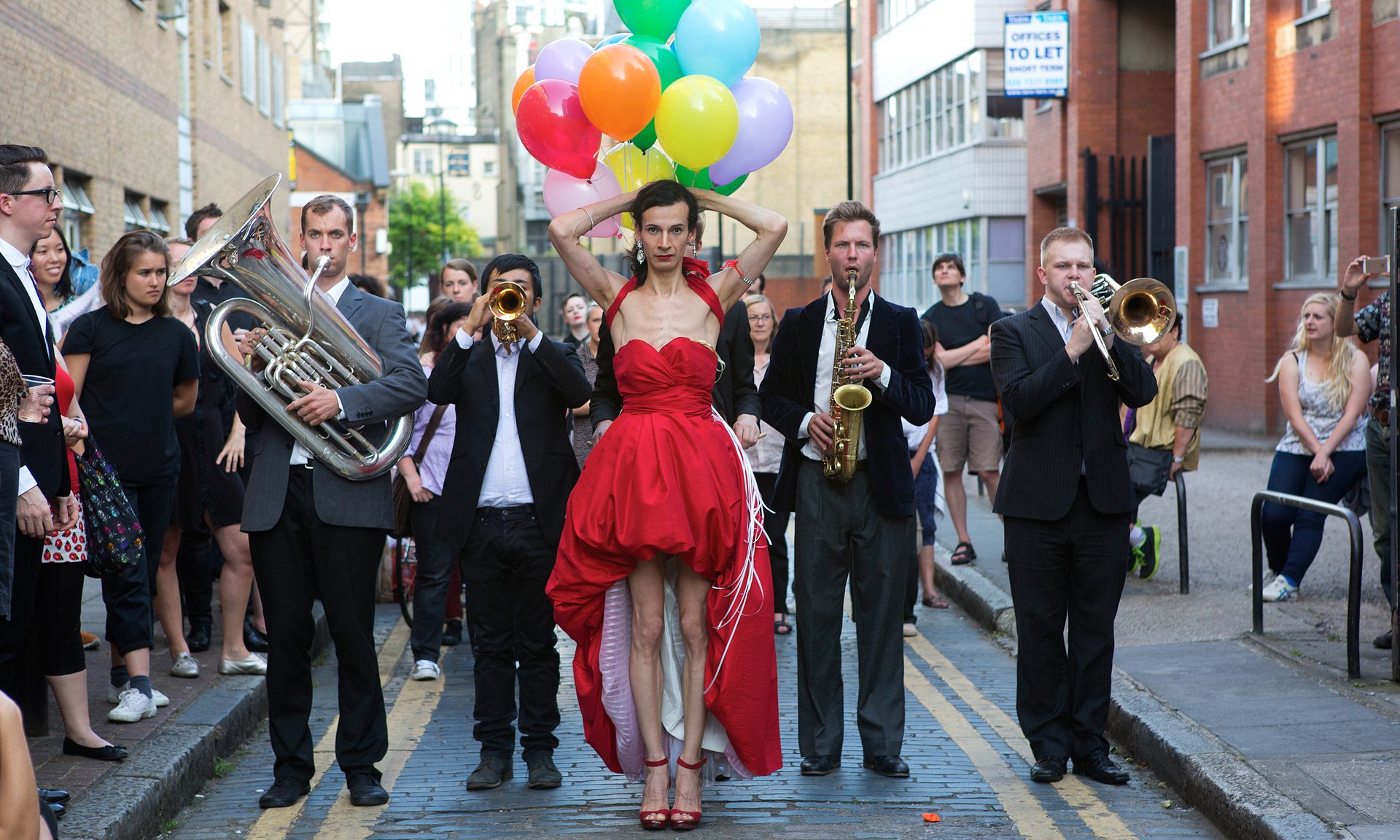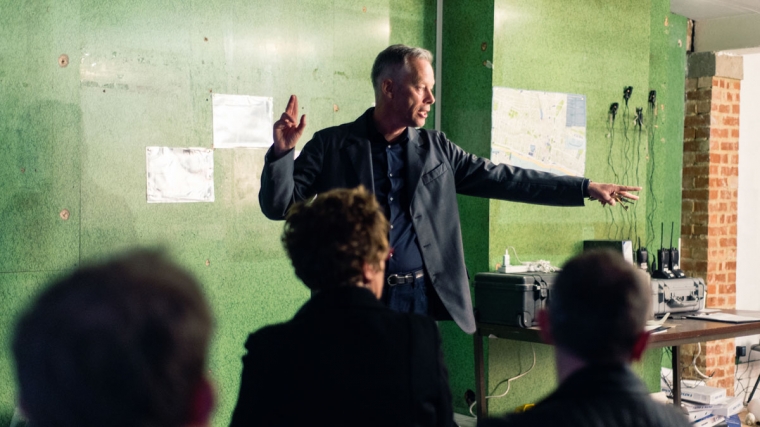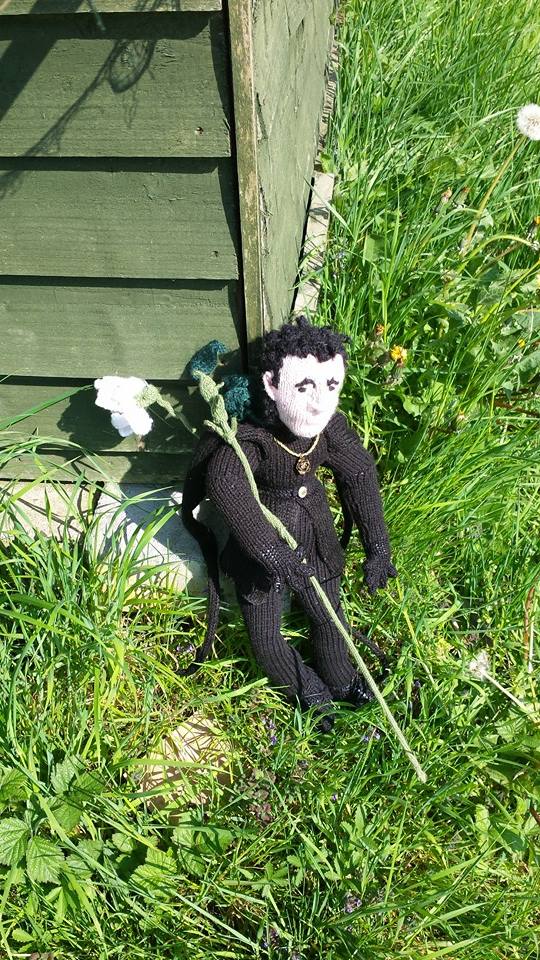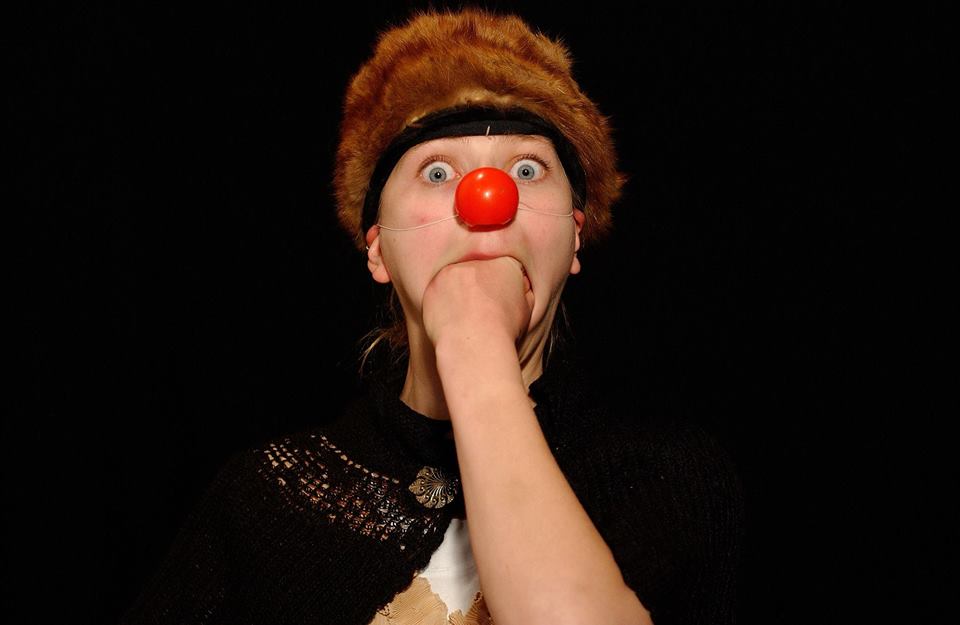Dorothy Max Prior on the wonderful training for actors and clowns to be found at The Actors Space near Barcelona
Are you ready? Are the other players ready? Is the audience ready? It is day one of The Art of Comedy, a week-long residential course at the beautiful venue in the Catalan countryside that is The Actors Space, and already we are getting to the crux of the matter.
We have done our warm-up, and we are on exercise one – and facilitator Simon Edwards is on our case from the start. All that is required is for us to enter the space in normal everyday mode, one at a time, to acknowledge the audience in whatever way we like, and to exit. ‘Give it space!’ says Simon, and ‘Just be with whatever you’re feeling; whatever is going on’. Next, a group exercise. There’s a classic comedy prop – a bench, and four players. Entrances, one at a time. Acknowledge the audience; acknowledging the new arrival. Negotiate the space between you. Next, Pass the Smile, sitting four in a row: ’Remember to receive before you give to the next person’. Build the smile into laughter, into hysteria, into tears, and diminish. Simon is both strict and encouraging at the same time. He is neither too touchy-feely nor too admonishing. He has something positive to say about everyone, but he makes it clear where there’s room for improvement. And there’s a lot of room for improvement, for all of us – hardcore pros with 30 years’ experience and young students alike.
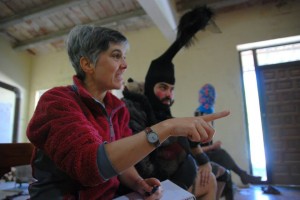
Marian Masoliver, teacher and co-director of the Actors Space
The second session of the day – and days here are full-on, with four working sessions between 9am and 7pm, although paced well with breaks – is with Marian Masoliver. Simon and Marian are co-directors of The Actors Space, and they run most of the courses there together – although there a few guest teachers, such as Maria Codinachi, who co-runs the Bouffon course with Marian, and yours truly, running Eccentric Dance for Actors and Clowns in June. They are both alumni of the Lecoq school in Paris, and have that training as their shared territory, but they have developed the work both together and separately, bringing other experiences into play. Simon worked for many years with the UK’s Kneehigh Theatre, and Marian is a former performer with legendary Catalan company La Fura del Baus.
Marian’s session starts with some work on our own natural stance, then some classic Lecoq ‘body parts’ exercises, progressing into an exploration of Comédie Humaine, using Commedia-style half-masks . We work on getting to know the mask by ‘puppeteering’ it around the space, then on how best to don the mask: ‘Make sure your eyes can see and your mouth can speak.’ And then Marian asks us to ask ourselves: Who is the mask? We are encouraged to make our mask characters the same sex and nationality as ourselves, but they can be any age, and can be radically different to ourselves in other ways. Some of us have done a fair amount of mask work before, and some are new to it, but for all of us it great to be led through the essential ‘rules’ so thoroughly and efficiently. Keep your head up and towards the audience; don’t touch the mask with your hands; don’t get too close to the audience or it kills the magic of the mask; keep your distance from the other masks, at least a metre.
Simon joins Marian to watch the scenes we’ve devised. His notes are many and various: The masks play out to the audience, alongside rather than to the other masks. The audience are in the world, but not brought into the action. Say yes not no to the propositions brought to you by the other masks. Build the conflict. He also has some questions for us: What is the game? Who is the mask? What does the mask want?
I’ve worked on a scene with an American woman called Jade and a very young German man called Aurelius. Our sketch is set in a convent, featuring two lascivious old nuns and the new priest, who soon realises that he is one in a long line of Fathers who have come to a sticky end in the covent. Simon and Marian like the basic idea, and like most of what we’ve devised, except the ‘zombie’ ending, in which the young priest rises from the dead on Easter Sunday. Once you step out of the territory of the purely human experience, you’re on dodgy territory with the Comédie Humaine, we are told. Stay clear of supernatural beings, fantasy creatures, or even animals. These masks occupy the human world. They are at their best when they are exploring the base desires: food, sex, power, money.
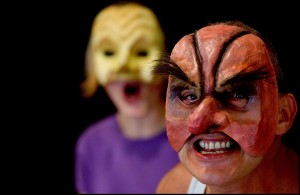
Mask work at the Actors Space
I ask Simon and Marian about their chosen methodology, which starts with mask and moves to red nose – which Jacques Lecoq called ‘the smallest mask in the world’ – and then to absurd costume, circus and theatre clown, to the comic presence of the actor, and finally to playing comedy to-camera. Marian explains their approach:
‘In one week we follow an evolution of comic acting that covers more than 500 years: from the birth of Commedia Dell’Arte (half mask theatre) in the 16th century to the discovery of one’s own personal clown with the help of the red nose; and to then go beyond pre-determined styles to the necessary freedom for today’s comic creators.’
This approach has grown out of Marian and Simon’s own practice, and the experience they had when participating in Lecoq’s research.
In contrast to the mask work, when choosing a costume for ourselves, we are encouraged to choose things that don’t hide our face. There’s a wardrobe of things to play with, or we can use things that we’ve brought along ourselves. Now, we are working with an exposed face, and a very mobile head. We walk, looking up to the sky, down to the earth, out to the horizon. We meet and greet other characters. We create 10-minute showbiz numbers or ‘clown numeros’. We are working in ‘the world of the demonstrative’.
‘One realm of relationship is the demonstrative, as in a circus or cabaret,’ says Simon. ‘The clowns come in to perform their act for the audience, or this is what it seems; in fact the clown plays with the audience. The clown is transparent – as they try to survive the world and themselves, their inner feelings, thoughts and reactions spill out, for the pleasure of all.’ The comic actor needs to be aware of this dynamic relationship and thus subverts the perceptions and expectations of the audience.
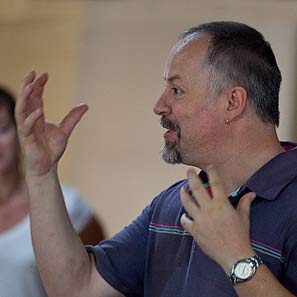
Simon Edwards, teacher and co-director of the Actors Space
So, a clown numero: I work with a Spanish woman called Isobel, and we create our own red-nose soft-shoe-shuffle version of There’s No Business Like Show Business. Simon dons a hat and announces that he is Kevin the producer, auditioning people for his new show – this allowing him to take on the persona of grumpy critic tearing the performance to bits. When he has the hat on, he is nasty Kevin; when it is off, he is friendly Simon. ‘What on earth was that? What do you think you are doing?’ Kevin says to me and Isobel. ‘She’s not my usual partner,’ my character finds herself saying, snootily. ‘I just started working with her today. The other one I had was much better’. Isobel’s character stares at the floor morosely and makes small whimpering noises.
We keep to these costumes for the next few days. In the choosing of the costume, and the continuing work with the same costume, I’m reminded of the Bouffon workshop that I’d also attended at The Actors Space. Although both, obviously, operating within the comic register, clown and bouffon are very different:
‘The clown is profoundly human and we identify and laugh at the fragility and weakness that we all share,’ says Marian. ‘The bouffon is not human; it is from another dimension. This non-human being laughs at and mocks humanity, and at our common vulnerabilities.’
A clown can be dark; or can shine a light on life’s dark spots. But the clown is always human – one of us, even if a nasty one.
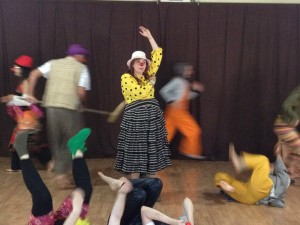
The Art of Comedy workshop August 2015
Sometimes we work with the red nose, and sometimes without. Now that we are often without mask or nose, we are often reminded that the mask is still there. Simon explains this thus: ‘When we say “remember to keep the mask” we are reminding the student to maintain their comic presence, and to keep the level of projection that the mask teaches, and which performing comedy requires.’ And further, on maintaining our comic presence, we are told to remember that once we up the ante, we have to maintain that level. ‘You can’t return to your entrance mode,’ Simon warns.
Always, throughout the week, we return to the performer’s relationship with the audience. ‘Have the problem, experience it, share it with the audience’. No need to overplay: just share the state with the audience.
So does the clown really suffer? No. Stay in clown. Stay with the audience. Aesthetic emotion is the goal, not real pain. ‘Everything is amplified in comedy,’ says Simon. ‘We laugh because we identify. If a clown really suffers it is not comic anymore, it becomes tragic. This can be valid for a moment but it cannot endure in the comic register (it was a trick, or he was kidding), or there must be another step of pain and suffering which takes us beyond the tragic to a heightened state and situation of ridiculousness.’
We also talk about – and work out in devising – such tricky questions as how to play with boredom and repetition. It’s a delicate line. Boredom can be an interesting game, and repetition can be a great technique. But don’t really bore the audience… We talk about ‘ruptures’: the process of setting up a situation, then breaking it. Or at least, breaking expectations, or introducing a spanner into the works, or creating conflict, or doing something that is unexpected – there are many different sorts of ruptures. We watch each other’s scenes and note what is working. Often things are strongest when the set-up is totally clear. A dinner party, a first date, an audition. Whatever it is, we need to believe in it, believe in the truth of the situation, so that ‘there is something to rupture’. Taking this idea further, we are given a classic Lecoq exercise: the clowns ‘do’ Shakespeare. It can’t be disruption and subversion from the start. We have to understand what play it is. We have to see the clowns trying their best. We then really appreciate it when things take an unexpected turn, whatever that might be.
We are cautioned to beware of velocity; to really work on the rhythm and the pace of the piece. To finely tune our instrument – the body. Make us laugh – but be honest. ‘Keep it real’ is our mantra for the week.
The final day is mostly spent working on the comic presence on film. As someone who has spent a lot of time as a street arts and cabaret performer, this proves to be challenging. How to maintain comic presence without overblown parody? ‘The camera is a microscope,’ says Simon ‘We must not theatrically project as the performance is already being captured. When we put our shared humanity under this microscope we must keep things subtle and avoid exaggeration. The more we trust and keep it simple, the more the audience can enjoy the result.’
I’ve noticed that often during the week, Simon and Marian often use the word ‘clown’ as a verb rather than a noun. To clown. I ask them why, and Marian says: ‘People try to create ‘a clown’ but you can’t because when you are in a situation – with all your human wishes and desires – where you try and achieve something, and then suffer the consequences of your actions, you already are one!’
And so here we are – clowns one and all.
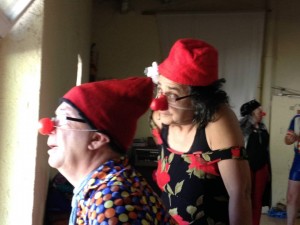
All images courtesy of the Actors Space
The Actors Space is a renowned international centre of theatre and film, located in a place of outstanding natural beauty, only one hour from Barcelona. They provide high quality training for actors, directors, writers, teachers and students of dramatic art. www.actors-space.org
Courses taught by Simon Edwards and Marian Masoliver:
The Creative Actor (residential)
16–24 July 2016 (inclusive)
The Art of Comedy (residential)
29 July – 6 August 2016 (inclusive)
Screen Acting (residential)
20–28 August 2016 (inclusive)
Directing Performance (residential)
1–9 September 2016 (inclusive)
Book all of the above courses via the Actors Space website
Dorothy Max Prior will be teaching Eccentric, Comic and Popular Dance for Actors & Clowns (Residential) at The Actors Space 6–12 June 2016 (inclusive). See http://actors-space.org/courses-workshops/other-courses-and-activities/
Please note that this course needs to be booked with Aurelius Productions, not via the Actors Space. Please email aureliusproductions@gmail.com or for full information, and to pay via Paypal, see dorothysshoes1.blogspot.co.uk
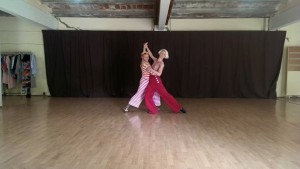
Eccentric Dance workshop 2015

